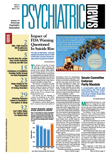The number of suicides of youth under age 20 made a dramatic leap from 2003 to 2004, representing an increase of 18.2 percent. Many experts are questioning whether the increase is tied to a contemporaneous steep decline in antidepressant prescriptions filled for this population that began after the Food and Drug Administration issued its first strong warnings about the drugs' links to increased suicidality in March 2004.
The increase is especially noticeable because “intentional self-harm,” as the federal Centers for Disease Control and Prevention (CDC) defines the category, was the only cause of death for those under the age of 20 to increase in rate between the two years.
The suicide rate was disclosed in a report by researchers at the CDC's National Center for Health Statistics published in the February Pediatrics.
The increase in suicide deaths paralleled a 20 percent drop in the number of prescriptions written for antidepressant medications for patients under age 19. That decline occurred amid a media frenzy during 2003 concerning a series of U.S. Food and Drug Administration (FDA) advisory committee meetings and Congressional hearings regarding data possibly linking antidepressant medications with an increased risk of suicidal thoughts and behaviors compared with placebo (Psychiatric News, September 2, 2005).

In October 2004 the FDA required manufacturers of all antidepressants marketed in the United States to add a strongly worded black-box warning on the drugs' labels. APA, as well as many mental health clinicians and researchers, believes that the new warning, which did not appear on drug labels until spring 2005, scared a large number of prescribers and parents of children with depression away from antidepressant medications. Now, some experts are questioning whether the downturn in prescribing could be directly linked to the increased number of suicides.
“This is very disturbing news,” said David Fassler, M.D., an APA trustee-at-large and a child and adolescent psychiatrist in Vermont.“ The current data suggest that the decreased use of these medications is, in fact, associated with an increase in actual deaths attributable to suicide.”
David Shern, Ph.D., president and CEO of Mental Health America, echoed Fassler's concern.
The addition of the black-box warning to antidepressants' labeling and the media attention surrounding it, Shern said in a prepared statement,“ have created yet another formidable barrier to treatment for youth—by scaring young people and parents away from care—and contributing to a decline in treatment. Without treatment, suicide is a real risk.”
The federal government, he concluded, “must move aggressively to comprehend any potential consequences of [its] actions on the lives of youth.”
The CDC's researchers reported that the suicide rate for those aged 1 to 19 in 2003 was 2.2 suicides per 100,000 population, equating to 1,737 deaths. The rate rose to 2.6 per 100,000 in 2004, equating to 1,985 deaths, an increase of 18.2 percent over the prior year (see chart on page 1).
The suicide rate for youth aged 10 to 14 increased 8.3 percent from 2003 to 2004, from 1.2 per 100,000 (244 suicides) to 1.3 per 100,000 (283 suicides). The rate for those aged 15 to 19 increased 12.3 percent in that same period, from 7.3 per 100,000 (1,487 suicides) to 8.2 per 100,000 (1,700 suicides).
The FDA did not respond by press time to requests from Psychiatric News for input on this story.
A preliminary report of the suicide data was discussed at a public meeting of the Psychopharmacological Drugs Advisory Committee in December (Psychiatric News, January 19) during consideration of a newly released meta-analysis of suicidal thoughts and behaviors among adults in clinical trials of antidepressants.
The FDA meta-analysis found an elevated risk of suicidal thoughts and behaviors in young adults, up to about age 25 or 30. The advisory committee members, however, seemed most concerned over the possibility that the new data, again linking antidepressant medications to an increased risk of suicidality, could cause more fear and result in more patients' not taking medically necessary medications. The advisory committee urged the FDA to seek more balance in the labeling of antidepressant medications by not only discussing the risks associated with taking the medication, but also pointing out that untreated depression itself is a major cause of suicide.

